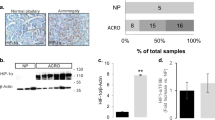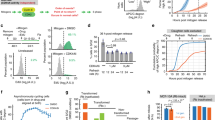Abstract
Low p27 expression in many human cancers is a prognostic indicator for poor outcome. While analysing the mechanism by which p27 deficiency contributed to tumor development in the Rb+/− mouse model, we identified a role for p27 as a proapoptotic tumor suppressor. We examined the cell cycle and apoptotic response of these pituitary tumor cells to the dopamine analog bromocriptine as well as the expression of Arf and other cell cycle and apoptotic regulators in these tumors. We also examined the expression of Arf and its function in mouse embryo fibroblasts either singly or doubly deficient for Rb and p27. From these studies, we concluded that the absence of p27 disabled the trigger for an Arf-dependent apoptotic response in Rb−/− tumor cells. This suggests a novel mechanism by which the loss of p27 may impact on tumor development.
This is a preview of subscription content, access via your institution
Access options
Subscribe to this journal
Receive 50 print issues and online access
$259.00 per year
only $5.18 per issue
Buy this article
- Purchase on Springer Link
- Instant access to full article PDF
Prices may be subject to local taxes which are calculated during checkout






Similar content being viewed by others
References
Arita J, Hashi A, Hoshi K, Mazawa S and Suzuki S . (1998). Neuroendocrinology, 68, 163–171.
Casaccia-Bonnefil P, Tikoo R, Kiyokawa H, Friedrich Jr V, Chao MV and Koff A . (1997). Genes Dev., 11, 2335–2346.
Chronwall BM, Millington WR, Griffin WS, Unnerstall JR and O'Donohue TL . (1987). Endocrinology, 120, 1201–1211.
de Stanchina E, McCurrach ME, Zindy F, Shieh SY, Ferbeyre G, Samuelson AV, Prives C, Roussel MF, Sherr CJ and Lowe SW . (1998). Genes Dev., 12, 2434–2442.
Di Cristofano A, De Acetis M, Koff A, Cordon-Cardo C and Pandolfi PP . (2001). Nat. Genet., 27, 222–224.
Dimri GP, Itahana K, Acosta M and Campisi J . (2000). Mol. Cell Biol., 20, 273–285.
Drissi H, Hushka D, Aslam F, Nguyen Q, Buffone E, Koff A, van Wijnen A, Lian JB, Stein JL and Stein GS . (1999). Cancer Res., 59, 3705–3711.
Durand B, Fero ML, Roberts JM and Raff MC . (1998). Curr. Biol., 8, 431–440.
Fero ML, Rivkin M, Tasch M, Porter P, Carow CE, Firpo E, Polyak K, Tsai LH, Broudy V, Perlmutter RM, Kaushansky K and Roberts JM . (1996). Cell, 85, 733–744.
Franklin DS, Godfrey VL, Lee H, Kovalev GI, Schoonhoven R, Chen-Kiang S, Su L and Xiong Y . (1998). Genes Dev., 12, 2899–2911.
Hanahan D and Weinberg RA . (2000). Cell, 100, 57–70.
Herrera RE, Sah VP, Williams BO, Makela TP, Weinberg RA and Jacks T . (1996). Mol. Cell Biol., 16, 2402–2407.
Ho A and Dowdy SF . (2002). Curr. Opin. Genet. Dev., 12, 47–52.
Igney FH and Krammer PH . (2002). Nat. Rev. Cancer, 2, 277–288.
Jacobs JJ, Keblusek P, Robanus-Maandag E, Kristel P, Lingbeek M, Nederlof PM, van Welsem T, van de Vijver MJ, Koh EY, Daley GQ and van Lohuizen M . (2000). Nat. Genet., 26, 291–299.
Kiyokawa H, Kineman RD, Manova-Todorova KO, Soares VC, Hoffman ES, Ono M, Khanam D, Hayday AC, Frohman LA and Koff A . (1996). Cell, 85, 721–732.
Lloyd RV, Erickson LA, Jin L, Kulig E, Qian X, Cheville JC and Scheithauer BW . (1999). Am J. Pathol., 154, 313–323.
Lowenheim H, Furness DN, Kil J, Zinn C, Gultig K, Fero ML, Frost D, Gummer AW, Roberts JM, Rubel EW, Hackney CM and Zenner HP . (1999). Proc. Natl. Acad. Sci. USA, 96, 4084–4088.
Millard SS, Yan JS, Nguyen H, Pagano M, Kiyokawa H and Koff A . (1997). J. Biol. Chem., 272, 7093–7098.
Nakayama K, Ishida N, Shirane M, Inomata A, Inoue T, Shishido N, Horii I and Loh DY . (1996). Cell, 85, 707–720.
Nikitin A and Lee WH . (1996). Genes Dev., 10, 1870–1879.
Palmqvist R, Stenling R, Oberg A and Landberg G . (1999). J. Pathol., 188, 18–23.
Parisi T, Pollice A, Di Cristofano A, Calabro V and La Mantia G . (2002). Biochem. Biophys. Res. Commun., 291, 1138–1145.
Park MS, Rosai J, Nguyen HT, Capodieci P, Cordon-Cardo C and Koff A . (1999). Proc. Natl. Acad. Sci. USA, 96, 6382–6387.
Philipp-Staheli J, Kim KH, Payne SR, Gurley KE, Liggitt D, Longton G and Kemp CJ . (2002). Cancer Cell, 1, 355–368.
Philipp-Staheli J, Payne SR and Kemp CJ . (2001). Exp. Cell. Res., 264, 148–168.
Porter PL, Malone KE, Heagerty PJ, Alexander GM, Gatti LA, Firpo EJ, Daling JR and Roberts JM . (1997). Nat. Med., 3, 222–225.
Serrano M, Lin AW, McCurrach ME, Beach D and Lowe SW . (1997). Cell, 88, 593–602.
Sherr CJ . (1998). Genes Dev., 12, 2984–2991.
Sherr CJ . (2001). Nat. Rev. Mol. Cell Biol., 2, 731–737.
Sherr CJ and Weber JD . (2000). Curr. Opin. Genet. Dev., 10, 94–99.
Swerdlow RH . (1998). Drugs Aging, 13, 263–268.
Tong W, Kiyokawa H, Soos TJ, Park MS, Soares VC, Manova K, Pollard JW and Koff A . (1998). Cell Growth Differ., 9, 787–794.
Tsihlias J, Kapusta L and Slingerland J . (1999). Annu. Rev. Med., 50, 401–423.
Weber JD, Taylor LJ, Roussel MF, Sherr CJ and Bar-Sagi D . (1999). Nat. Cell Biol., 1, 20–26.
Williams BO, Remington L, Albert DM, Mukai S, Bronson RT and Jacks T . (1994). Nat. Genet., 7, 480–484.
Yin D, Tamaki N, Kokunai T, Yasuo K and Yonezawa K . (1999). J. Clin. Neurosci., 6, 326–331.
Zezula J, Casaccia-Bonnefil P, Ezhevsky SA, Osterhout DJ, Levine JM, Dowdy SF, Chao MV and Koff A . (2001). EMBO Rep., 2, 27–34.
Zindy F, Eischen CM, Randle DH, Kamijo T, Cleveland JL, Sherr CJ and Roussel MF . (1998). Genes Dev., 12, 2424–2433.
Acknowledgements
We thank John Petrini (MSKCC), Stacy Blain (MSKCC), Eric Holland (MSKCC), Gary Stein (University of Massachusetts, Worcester), and Alfred Knudson (Fox Chase Cancer Center) for comments on the manuscript. We are also thankful to Katia Manova and Scott Kerns of the Molecular Cytology facility for graphics assistance. This work was supported by funds from the NCI (AK, CCC, PPP), fellowships from Ministerio de Ciencia y Tecnologia (CC), the Pew Foundation (AK) and the Hirschl Trust (AK), as well as the Cancer Center Core Grant from NCI.
Author information
Authors and Affiliations
Corresponding author
Rights and permissions
About this article
Cite this article
Carneiro, C., Jiao, M., Hu, M. et al. p27 deficiency desensitizes Rb−/− cells to signals that trigger apoptosis during pituitary tumor development. Oncogene 22, 361–369 (2003). https://doi.org/10.1038/sj.onc.1206163
Received:
Revised:
Accepted:
Published:
Issue Date:
DOI: https://doi.org/10.1038/sj.onc.1206163
Keywords
This article is cited by
-
Skp2 is required for survival of aberrantly proliferating Rb1-deficient cells and for tumorigenesis in Rb1+/− mice
Nature Genetics (2010)
-
Defective DNA double-strand break repair underlies enhanced tumorigenesis and chromosomal instability in p27-deficient mice with growth factor-induced oligodendrogliomas
Oncogene (2010)
-
Different cooperating effect of p21 or p27 deficiency in combination with INK4a/ARF deletion in mice
Oncogene (2004)
-
Acute mutation of retinoblastoma gene function is sufficient for cell cycle re-entry
Nature (2003)



